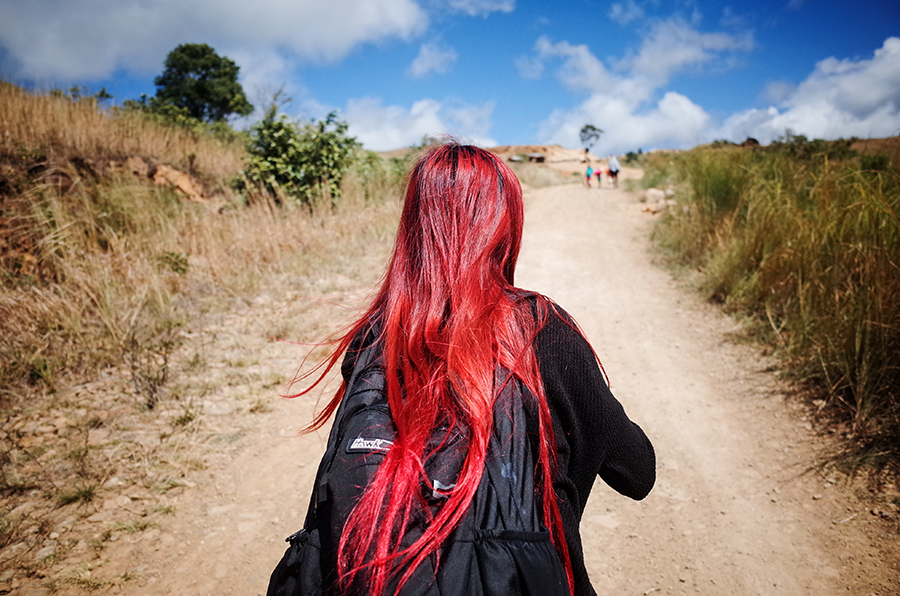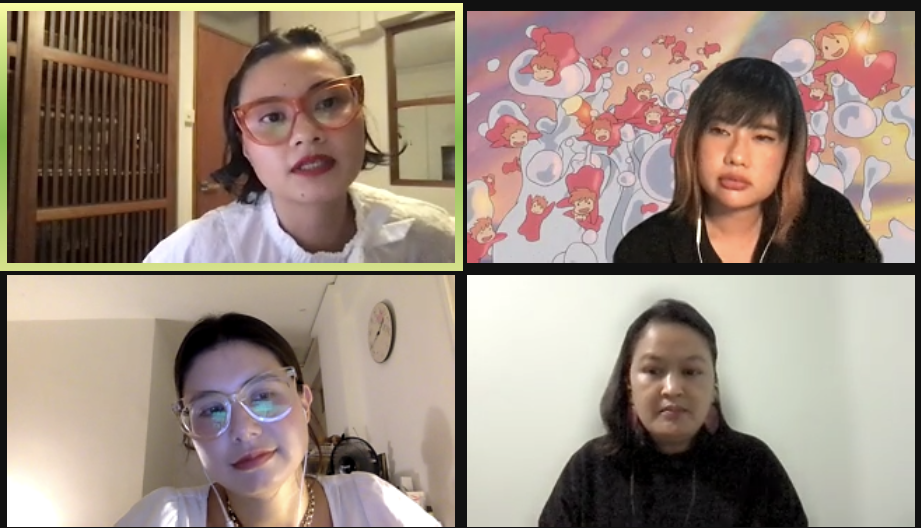A Stubborn Bloom, Ennuh Tiu & Uma Bista on Inheritance
Objectifs’ sixth Women in Film & Photography showcase opened on 11 Nov 2021 with the theme Inheritance. The first of four weekly online artist talks featured exhibiting artists A Stubborn Bloom, Ennuh Tiu and Uma Bista in conversation with the show’s curators, Emmeline Yong and Leong Puiyee from Objectifs.
This recap of the session has been paraphrased for brevity.
A STUBBORN BLOOM
A Stubborn Bloom is a multidisciplinary collective started by visual artist Stephanie Jane Burt and fashion researcher and curator Daniela Monasterios-Tan, exploring femininity through film, fashion and material culture. They are presenting their short film, Home Economics with A Stubborn Bloom at the exhibition.
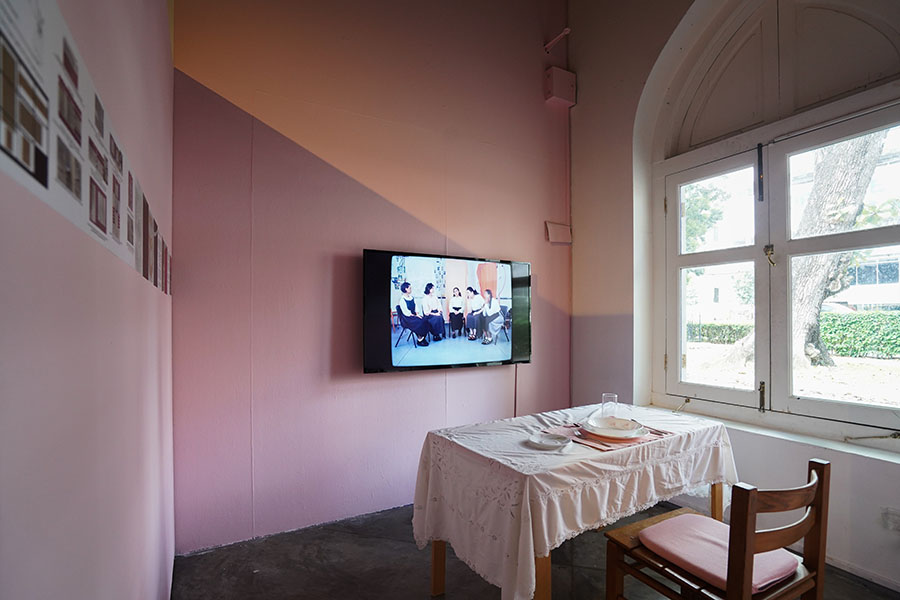
Installation view of “Home Economics by A Stubborn Bloom”, Objectifs Chapel Gallery
A Stubborn Bloom’s research originates from Daniela and Stephanie’s many common interests, organic conversations, questions and observations. Their methods include frequent references to films such as Sofia Coppola’s works, literature, archival research, and using Instagram as a platform to share their research.
Research into “adjacent objects — consumer products that were marketed to women through fashion”, at a time when, post-independence, double income families in Singapore were on the rise, deeply informed Home Economics with A Stubborn Bloom. Daniela and Stephanie visited old businesses across the island to source for objects and props such as flowers, utensils and cutlery for the film, and began to examine more closely “the way that the design of objects is gendered, through colour, materials, and even ergonomics”.
They also stayed true to the source material — home economics textbooks — by using illustrations and diagrams such as recommended hairstyles and postures for well-groomed women as references for their actors’ looks and gestures, recipes such as methods of preparing a Swiss roll, and borrowing text verbatim from the texts for the film’s voiceover, to “bring the words to 2021 and get us thinking about what sounds strange to the ear and what has changed and what hasn’t”.
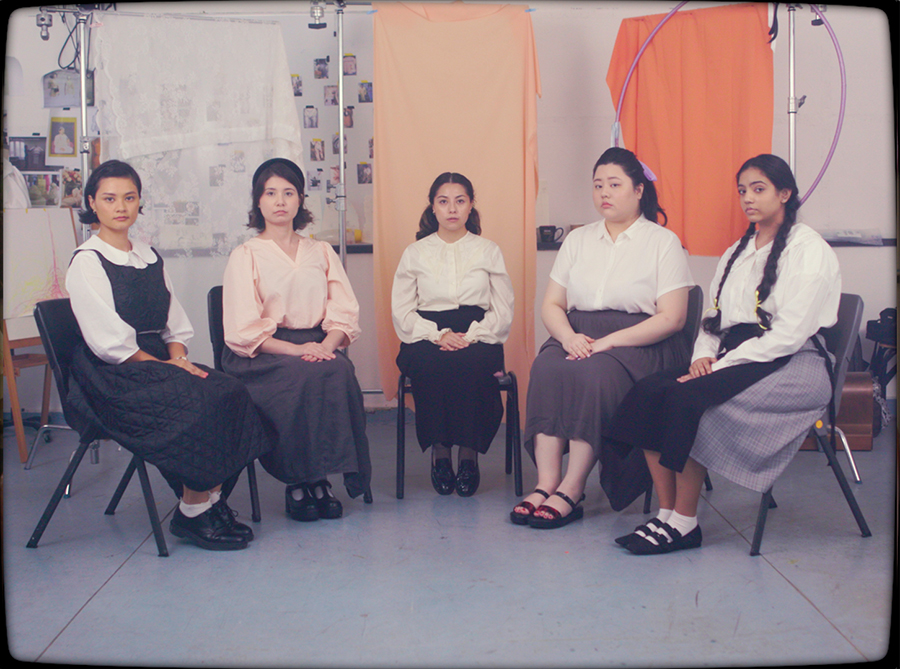
A Stubborn Bloom closely referenced illustrations and texts in home economics textbooks in their actors’ looks and gestures for the short film.
Through working on Home Economics with A Stubborn Bloom, they “learnt a lot about what we have inherited as young girls from previous generations of policymakers in Singapore”. Upon looking into the discourse on the value of non-academic subjects, including the arts, sports and music, in which home economics was cast aside as the country focused on economic development, they were affirmed to come across the words of women’s advocate Dr Nalla Tan, who in a 1976 forum “spoke of both aesthetic comfort and pleasure that home economics can teach us about…having pride in one’s home and appreciation of excellence”.
Despite being a heavily gendered subject, Daniela and Stephanie were impressed by how some textbooks not only covered cooking and sewing but even bits of ikebana (flower arrangement), interior design principles and how to be a good consumer of clothing and materials — all of which hold a lot of relevance in the design and fashion industries today.
ENNUH TIU
Ennuh Tiu is a Filipina photographer with Chinese ancestry whose work explores themes of self discovery, identity and personal relationships. She is presenting her series, All That’s Left, All in Red at the exhibition.
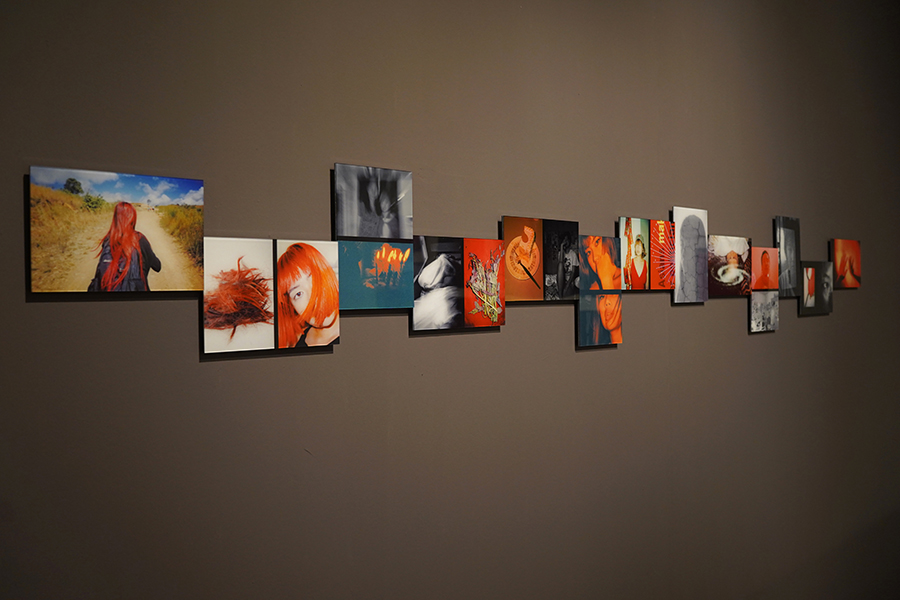
Installation view of “All That’s Left, All in Red”, Objectifs Chapel Gallery
Ennuh does not speak Chinese, and growing up, she identified more with her majority Filipina identity. When she was aged nine or 10, she was asked to remove a red accessory she had on before attending the wake of a relative who had passed away. She shared: “This was my favourite necklace at the time. Being young, and not even knowing yet what traditions were and why they should be followed, I was puzzled why I had to remove it”. On the other hand, it is a common tradition for Chinese families to wear red during happy occasions like birthday gatherings; questioning why her family followed this custom while not otherwise paying much heed to tradition, Ennuh would resist this by sometimes wearing pink.
Some years ago, Ennuh experienced personal losses in the form of losing people who “tied [her] to her Chineseness”, which caused a further disconnect from her Chinese identity. She shared: “It was a dark period of my life where I had to regain my sense of self after suddenly losing a lot of things familiar to me.”
Accepting that she had “no choice but to confront the reality she is in now”, Ennuh turned to art. Photography has helped her “grow around her loss and become comfortable with who she is, despite not being able to fully connect with an aspect of how she came to be”. Her series All That’s Left, All in Red deals with her “ongoing quest for her identity, and understanding herself through her personal history”. Identity interests her greatly as “it’s so important but so intangible and vague; you need to look beneath the surface to uncover the aspects and layers to it”.

Ennuh Tiu shares about her deeply personal series examining the resonances and dissonances of the colour red in her journey to reconnect with her Chinese heritage.
Ennuh’s journey of self-discovery through photography is not complete. She concluded: “It’s still an ongoing process of overcoming this alienation and disconnect I’m feeling. But there’s power that comes with being open to future discoveries and knowing myself.”
“I have learnt to embrace my truth, to go outside my comfort zone and that it’s okay to be vulnerable, and to share moments and memories that I tried so long to keep bottled up inside me. My experiences matters. My voice matters.”
UMA BISTA
Uma Bista is an independent photographer based in Nepal who works on visual narratives focused on gender inequality. Her project Stay Home, Sisters, which is exhibited at Objectifs, continues her work, deeply informed by her personal experiences, of taboos surrounding menstruation in Nepal. Though the practice is legally outlawed, it is still prevalent, with many women being subjected to a monthly ritual of isolation while on their period.
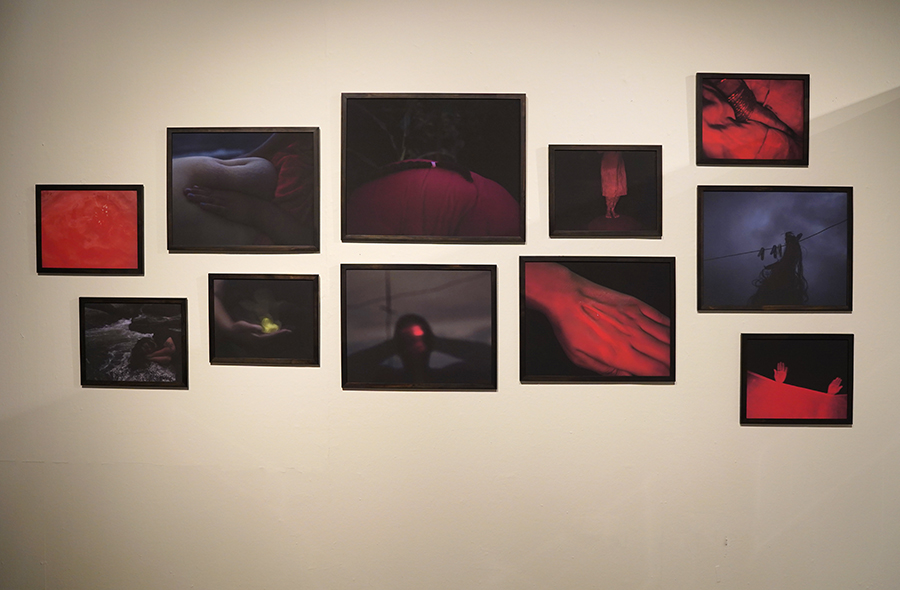
Installation view of “Stay Home, Sisters”, Objectifs Chapel Gallery
Uma recalls how she was confined for twelve days and restricted from going out when she got her first period. She was filled with fear and uncertainty and “is still trying to understand” her experience. In this long-term project, she is collaborating with a young generation of women who are learning how to navigate this cultural practice, and are “beginning to ask questions and push boundaries, finding ways to get freedom in their lives”.
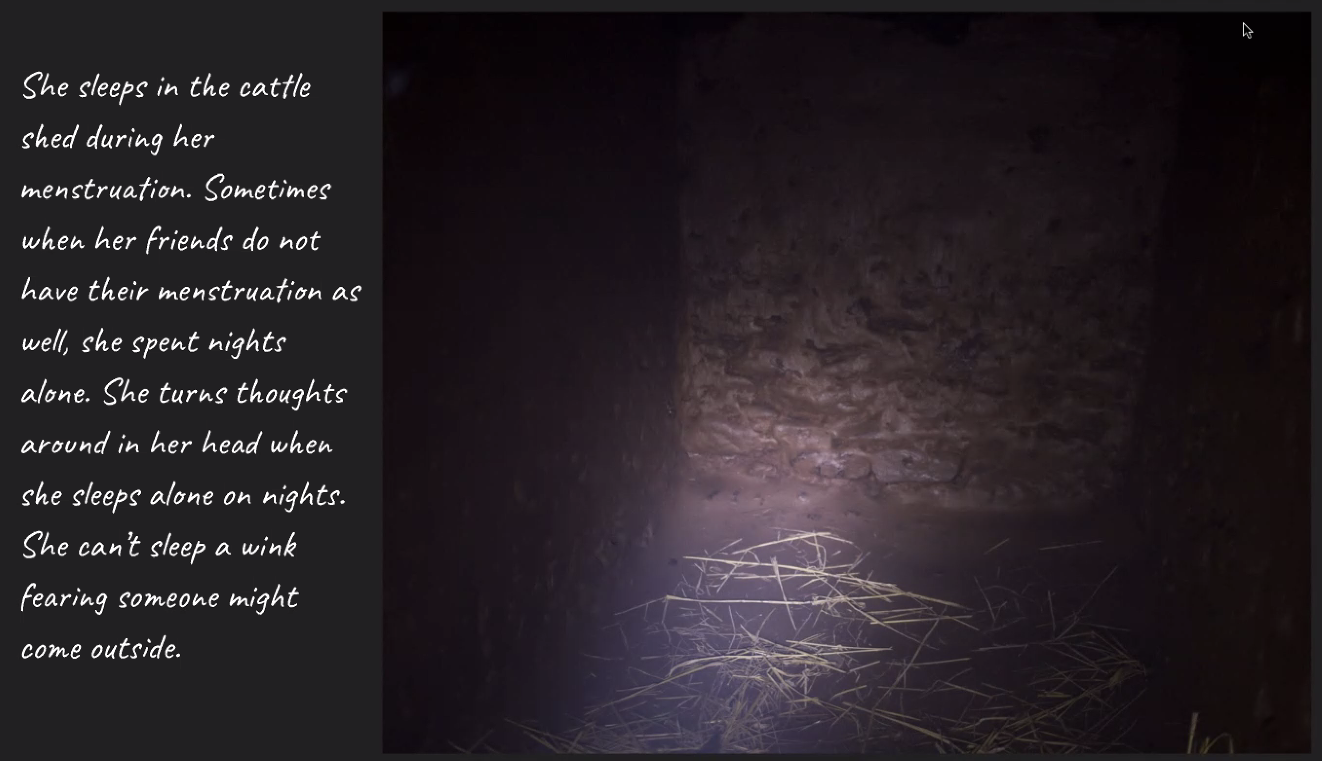
Uma Bista’s images and words evocatively depict the fear and anxiety of young women subjected to isolation outdoors while menstruating.
In addition to the physical discomforts of menstruation, the taboos calling for women in Nepal to be isolated outdoors “affects their everyday lives, relationships, family…everything”. It causes anxiety for the women who fear sleeping outdoors, and causes intergenerational strife: “We are told we may enjoy our freedoms outside but follow rules and restrictions inside the home. Uma shared: “But I question – who is outside? what is ‘outside’? who are ‘outsiders’? I started this project from my own experience, and I started from outside.”
In the first chapter of this long-term project, Our Songs from the Forest, which takes on a more photojournalistic approach, Uma was “working with other people and had to give them agency” in how they consented to be photographed. In the second chapter, Stay Home, Sisters, employs a more abstract style as she is “working by herself; it’s more about the feeling and the psychological trauma” she experienced. With the freedom to experiment and try different aesthetics, she sought to “find elements that are therapeutic and where she can redirect tension and anger, and also to find the place where she can feel happy and resilient”. The result is a series that is deeply moving and emotive.
In response to an audience member’s observation that “not all inheritance is desirable, but it’s something you don’t get to choose or decide”, Women in Film & Photography co-curator Emmeline Yong acknowledged the “complexity of inheritance: Inheritance is not binary; it can be a blessing or a burden, and sometimes both at the same time. Hopefully, that nuance comes across in the curation and works, and each audience member’s interpretation of the works will also be informed by their own background, heritage, beliefs…”
She concluded: “A group show featuring artists from very different backgrounds and practices is a recognition on our part that there are so many varied lived experiences. What is trying for one community by no means diminishes anyone else’s realities and struggles.”
Women in Film & Photography 2021 runs till 19 Dec, with exhibitions in Objectifs’ Chapel and Lower Galleries, weekly online artist talks, a curator and artist-led tour, and two short film screenings at The Projector. Visit our website for full details and to register / purchase tickets.

